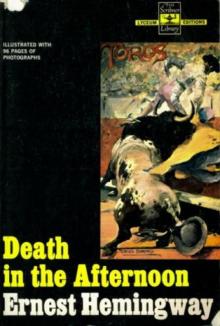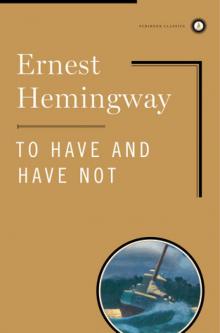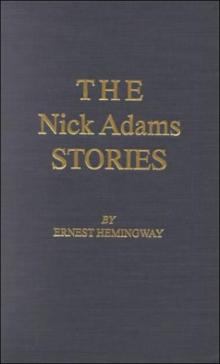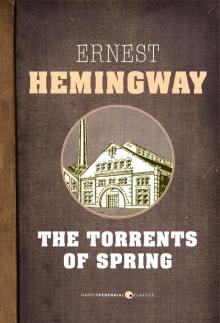- Home
- Ernest Hemingway
Dateline- Toronto Page 3
Dateline- Toronto Read online
Page 3
In reprinting these 172 identifiable articles—most of them signed “By Ernest M. Hemingway”—I have relied on the original published texts in the weekly and daily Toronto Star editions. As is the usual newspaper practice, the manuscripts were destroyed shortly after they were set in type in the print shop, so we shall never know exactly what Hemingway wrote, and what the Toronto copyreader added, deleted, or changed. I have not “corrected” Hemingway in the way Emily Dickinson’s early editors “corrected” her poetry, though I have changed typographical errors made by linotype operators and missed by proofreaders; and where editors have missed Hemingway’s notorious misspellings, such as in German place-names, I have silently spelled the word correctly. To have left it in its original wrong form would have achieved nothing. Though the Star editors or copyreaders may have added commas in Hemingway’s sentences, I have changed punctuation only on a few occasions where necessary for clarity or understanding or identity. In a very few cases I have added a word in square brackets for the same reasons. In the rare cases of doubtful grammar, I have made no changes. Hemingway may well have been writing idiomatically, or, even then, before he had fully developed his narrative style, valuing the way in which he said a thing more highly than grammatical niceties.
As for the titles, they were almost always newspaper headlines written on the Toronto Daily Star or Star Weekly copydesks according to the place and space of the articles on the newspaper page. They were rarely, if ever, by Hemingway himself. Thus, for bibliographical and historical purposes, I have put the original headings in the Table of Contents, and I have given the pieces more convenient and shorter titles in place of headlines. I have deleted all subheads in the stories. They, too, were not written by Hemingway but usually by the copydesk purely for typographical reasons to break up the large pages. In datelines on all out-of-Toronto news stories, I have retained the names of cities from which they were filed but removed the dates, for the more important dates of publication in the Star appear immediately below the titles.
“By Ernest M. Hemingway”—the “M.” was not dropped until later—appears on all but thirty-five of the dispatches, a few times misspelled, and twice “E. M. Hemingway.” One piece is by-line “Hem.” On twenty-four occasions the articles were unsigned; W. L. McGeary, librarian of the Toronto Star, to whom we are deeply indebted, has used office records and other verifi-able evidence to attribute many of these to Hemingway. I am also greatly indebted to Randall Scott Davis of La Crescenta, California, for discovering and identifying fourteen unsigned Hemingway contributions to the Toronto Star and the Star Weekly and two contributions with the by-line “By A Foreigner.” In addition, Hemingway used as a pseudonym the name of his then-newborn son, John Hadley, six times, usually because he had other signed pieces in the same issue of the Star. For the same reason he once used the by-line Peter Jackson, an invented name.
Unsigned pieces and those with by-lines other than “By Ernest M. Hemingway” or “By E. M. Hemingway” are noted in the Table of Contents. I have included one short piece entitled “Miss Megan George Makes Hit: ‘A Wonder’ Reporters Call Her,” published in the Daily Star, October 6, 1923, which Professor Carlos Baker has attributed to Miss Isobel Simmons of Oak Park, Illinois—because it carries Hemingway’s by-line.
Here, arranged chronologically between the covers of one volume for the first time, are all of Hemingway’s writings for the Toronto Star. Twenty-nine of these articles appear in my own By-line: Ernest Hemingway (Charles Scribner’s Sons, 1967). In spite of the novelist’s well-known resistance to efforts to collect his newspaper articles, no apology need be made for his reporting as reporting. Given Hemingway’s own rules for seeing what he saw and putting his pieces together in his own way, sometimes in an unorthodox way, it is fine stuff of which the Toronto Daily Star and the Toronto Star Weekly were proud. And much of it, over sixty years later, can still be read both as a record of the early Twenties and as evidence of how Ernest Hemingway learned the craft of writing.
William White
DATELINE:
TORONTO
Circulating Pictures
The Toronto Star Weekly
February 14, 1920
Have you a coming Corot, a modern Millet, a potential Paul Potter or a Toronto Titian temporarily adding whatever the new art adds to your home? If not it is possible to obtain one of the finest works of the moderns for a limited time for a mere fraction of its value.
The Circulating Pictures movement had its genesis in Toronto with Mrs. W. Gordon Mills of 63 Farnham Avenue, who last spring approached one of the foremost Canadian artists with the proposition that she might borrow a picture or two for the summer months. The artist, who is one of those that have introduced anger into art, readily consented and together they discussed the possibility of starting a circulating picture gallery. A number of young married women of Toronto enthusiastically took up the idea and now a gallery of circulating pictures is in full swing, or rather circulation.
According to Mrs. Kenneth T. Young, of 152 Bloor Street West, the circulating gallery is at present a very close corporation. After being asked by a writer for the Star Weekly for a story on the new application of Harvey’s principle of circulation, she talked it over with the other circulatees and they decided that the publication of their names or the names of the artists would give a taint of commercialism to the entire scheme which would quite spoil it. It wouldn’t be nearly so enjoyable to have one or two colorful joyous pictures in your home if you knew that any other responsible person might have them too. Imagine the élan to be derived from the public library if only a dozen or so persons were allowed to make use of it.
The reporter learned, however, that the principle under which the circulating gallery is operating is this: the young matrons select the pictures they wish from the rich, semi-starving or impecunious artists, depending upon the degree of the artist’s modernity and his facility with advertising, and pay ten percent of the picture’s assessed value. They then have possession of it for six months. The present scheme has been for each of the young women to have two pictures and after their kick—to use a slang phrase—has worn off, or after it has become so intensified as to make an exchange advisable, to trade with her nearest fellow member of the gallery.
For example, a picture by one of the artists, who, to quote Mrs. Mills, “has introduced anger into art,” might be so potent if hung in the living room that it might be exchanged after only a few days, perhaps at the husband’s request.
Another might be so powerfully pastoral in motif that the husband might be as easily controlled by it as the cobra by the fakir’s pipes. Such a picture might remain in the home indefinitely, doing yeoman service on the occasion of such domestic incidents as teething, the purchase of spring hats or the discovery of an overdrawn account.
Then there is the painter’s side of it. By this arrangement he receives something at least. His pictures are viewed by many more people and at the end of six months he receives them back ready for sale. But commercialism must not enter in.
A Free Shave
The Toronto Star Weekly
March 6, 1920
The land of the free and the home of the brave is the modest phrase used by certain citizens of the republic to the south of us to designate the country they live in. They may be brave—but there is nothing free. Free lunch passed some time ago and on attempting to join the Freemasons you are informed it will cost you seventy-five dollars.
The true home of the free and the brave is the barber college. Everything is free there. And you have to be brave. If you want to save $5.60 a month on shaves and haircuts, go to the barber college, but take your courage with you.
For a visit to the barber college requires the cold, naked valor of the man who walks clear-eyed to death. If you don’t believe it, go to the beginner’s department of the barber’s college and offer yourself for a free shave. I did.
As you enter the building you come into a well-appointed barbershop on t
he main floor. This is where the students who will soon graduate work. Shaves cost five cents, haircuts fifteen.
“Next,” called one of the students. The others looked expectant.
“I’m sorry,” I said. “I’m going upstairs.”
Upstairs is where the free work is done by the beginners.
A hush fell over the shop. The young barbers looked at one another significantly. One made an expressive gesture with his forefinger across his throat.
“He’s going upstairs,” said a barber in a hushed voice.
“He’s going upstairs,” the other echoed him and they looked at one another.
I went upstairs.
Upstairs there was a crowd of young fellows standing around in white jackets and a line of chairs ran down the wall. As I entered the room two or three went over and stood by their chairs. The others remained where they were.
“Come on you fellows, here’s another one,” called one of the white coats by the chairs.
“Let those work who want to,” replied one of the group.
“You wouldn’t talk that way if you were paying for your course,” returned the industrious one.
“Shut up. The government sends me here,” replied the nonworker and the group went on with their talking.
I seated myself in the chair attended by a red-haired young fellow.
“Been here long?” I asked to keep from thinking about the ordeal.
“Not very,” he grinned.
“How long before you will go downstairs?” I asked.
“Oh, I’ve been downstairs,” he said, lathering my face.
“Why did you come back up here?” said I.
“I had an accident,” he said, going on with the lathering.
Just then one of the non-workers came over and looked down at me.
“Say, do you want to have your throat cut?” he inquired pleasantly.
“No,” said I.
“Haw! Haw!” said the non-worker.
Just then I noticed that my barber had his left hand bandaged.
“How did you do that?” I asked.
“Darn near sliced my thumb off with the razor this morning,” he replied amiably.
The shave wasn’t so bad. Scientists say that hanging is really a very pleasant death. The pressure of the rope on the nerves and arteries of the neck produces a sort of anesthesia. It is waiting to be hanged that bothers a man.
According to the red-haired barber there are sometimes as many as one hundred men on some days who come for free shaves.
“They are not all ‘bums’ either. A lot of them take a chance just to get something for nothing.”
Free barbering is not the only free service to be obtained in Toronto. The Royal College of Dental Surgeons does dental work for all who come to the college at Huron and College streets. The only charge made is for materials used.
Approximately one thousand patients are treated, according to Dr. F. S. Jarman, D.D.S., head of the examination department of the clinic. All the work is done by the senior students under the direction of dental specialists.
Teeth are extracted free if only a local anesthetic is used, but a charge of two dollars is made for gas. According to Dr. Jarman, dentists in general practice charge three dollars to extract a single tooth. At the Dental College you can have twenty-five teeth extracted for two dollars! That should appeal to the bargain hunters.
Prophylaxis, or thorough cleaning of the teeth, is done at the college for from fifty cents to a dollar. In private practice this would cost from a dollar to ten dollars.
Teeth are filled if the patient defrays the costs of the gold. Usually from a dollar to two dollars. Bridgework is done under the same system.
No patients are refused at the Dental College. If they are unable to defray the cost of the materials used they are cared for just the same. The person who is willing to take a chance can surely save money on dentistry.
At Grace Hospital across Huron Street from the Dental College, there is a free dispensary for the needy poor that gives free medical attention to an average of 1,241 patients a month.
This service is only for the “needy” poor. Those of us who are poor, and are not adjudged needy by the social service nurse in charge, have to pay for the medical service. According to the figures at the Grace Hospital, over half of the cases treated last month were of Jewish nationality. The others were a conglomeration of English, Scotch, Italian, Macedonian and people of unknown origin.
Free meals were formerly served at the Fred Victor Mission, Queen and Jarvis streets. But the authorities at the mission state that there is almost no demand now. Prohibition and the war solved the “bum” problem and where formerly there was a long queue of “down-and-outs” lined up to receive free meal tickets, there is now only an occasional supplicant.
If you wish to secure free board, free room, and free medical attention there is one infallible way of obtaining it. Walk up to the biggest policeman you can find and hit him in the face.
The length of your period of free board and room will depend on how Colonel Denison [police magistrate] is feeling. And the amount of your free medical attention will depend on the size of the policeman.
Sporting Mayor
The Toronto Star Weekly
March 13, 1920
Mayor Church is a keen lover of all sporting contests. He is an enthusiast over boxing, hockey and all the manly sports. Any sporting event that attracts voters as spectators numbers His Worship as one of the patrons. If marbles, leapfrog, and tit-tat-toe contests were viewed by citizens of voting age, the mayor would be enthusiastically present. Due to the youth of the competitors the mayor reluctantly refrains from attending all of the above sports.
The other night the mayor and I attended the boxing bouts at Massey Hall. No; we didn’t go together, but we were both there.
The mayor’s entrance was impressive. He remained standing for some time bowing to his friends and people who knew him.
“Who is that?” asked the man next to me.
“That’s the mayor,” I replied.
“Down in front!” called out the man next to me.
The mayor enjoyed the first bout hugely. During it he shook hands with everyone around him. He did not seem to know when the bout stopped, as he was still shaking hands when the bell rang for the end of the last round.
Between the rounds, the mayor stood up and looked over the crowd.
“What is he doing—counting the house?” asked the man next to me.
“No. He is letting the sport-loving people look at their sport-loving mayor,” I said.
“Down in front!” shouted the man next to me in a rude voice.
During the next two bouts the mayor recognized a number of acquaintances in the crowd. He waved to all of them. He also shook hands with all the soldiers in uniform present, shaking hands with some of them two or three times to make sure.
Scotty Lisner was taking a bad beating in the next bout. The mayor’s eyes never strayed to the ring, but he applauded vociferously—whenever the crowd did.
He turned to his right-hand neighbor.
“Lisner is beating him, isn’t he?” said the mayor.
His neighbor looked at him piteously.
“I thought Lisner was the better fighter,” said the mayor, satisfied, looking eagerly around for someone to shake hands with.
At the end of the fight the referee consulted with the three judges and hoisted a hand of Lisner’s opponent as a sign of victory. The mayor stood up.
“I’m glad Lisner won!” he remarked enthusiastically.
“Is that really the mayor?” asked the man next to me.
“That is His Worship, the Sporting Mayor,” I replied.
“Down in front!” yelled the man next to me, in a rough voice.
It looked as though the mayor enjoyed the last bout best of all. Of course, he didn’t see it, but he discovered several people he had not shaken hands with, and also there was a great deal of booing and chee
ring. Sometimes the mayor would absent-mindedly boo when the crowd cheered but he always righted himself instinctively at once. He seemed able to shift a boo into a cheer with the same ease and grace of shoving a Ford into low gear.
At the close of the fights the Mayor absent-mindedly said, “Meeting’s dismissed,” and dashed for his motorcar, thinking he was at a City Council meeting.
The mayor is just as interested in hockey as he is in boxing. If cootie fighting or Swedish pinochle or Australian boomerang hurling are ever taken up by the voters, count on the mayor to be there in a ringside seat. For the mayor loves all sport.
Popular in Peace—Slacker in War
The Toronto Star Weekly
March 13, 1920
During the late friction with Germany a certain number of Torontonians of military age showed their desire to assist in the conduct of the war by emigrating to the States to give their all to laboring in munition plants. Having amassed large quantities of sheckels through their patriotic labor, they now desire to return to Canada and gain fifteen percent on their United States money.
Through a desire to aid these morally courageous souls who supplied the sinews of war we have prepared a few hints on “How to Be Popular Although a Slacker.”

 The Old Man and the Sea
The Old Man and the Sea Green Hills of Africa
Green Hills of Africa The Sun Also Rises
The Sun Also Rises Death in the Afternoon
Death in the Afternoon In Our Time
In Our Time For Whom the Bell Tolls
For Whom the Bell Tolls A Farewell to Arms
A Farewell to Arms A Moveable Feast
A Moveable Feast The Complete Short Stories of Ernest Hemingway
The Complete Short Stories of Ernest Hemingway Big Two-Hearted River
Big Two-Hearted River Winner Take Nothing
Winner Take Nothing Islands in the Stream
Islands in the Stream To Have and Have Not
To Have and Have Not The Snows of Kilimanjaro and Other Stories
The Snows of Kilimanjaro and Other Stories Across the River and Into the Trees
Across the River and Into the Trees By-Line Ernest Hemingway
By-Line Ernest Hemingway True at First Light
True at First Light Men Without Women
Men Without Women The Nick Adams Stories
The Nick Adams Stories Dateline- Toronto
Dateline- Toronto The Torrents of Spring
The Torrents of Spring Short Stories
Short Stories